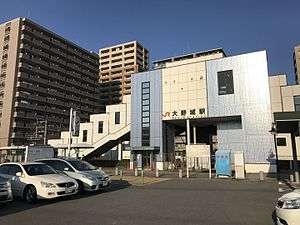Ōnojō Station
Ōnojō Station 大野城駅 | |
|---|---|
 Ōnojō Station in 2017 | |
| Location |
Ōnojō, Fukuoka Japan |
| Coordinates | 33°31′29″N 130°28′48″E / 33.5248°N 130.4801°ECoordinates: 33°31′29″N 130°28′48″E / 33.5248°N 130.4801°E |
| Operated by |
|
| Line(s) | ■ Kagoshima Main Line, |
| Distance | 87.4 km from Mojikō |
| Platforms | 2 side platforms |
| Tracks | 2 |
| Construction | |
| Structure type | At grade |
| Other information | |
| Status | Staffed ticket window (Midori no Madoguchi) |
| Website | Official website |
| History | |
| Opened | 10 June 1946 |
| Previous names | Shirakibaru (until 1989) |
| Traffic | |
| Passengers (FY2016) | 8,138 daily |
| Rank | 19th (among JR Kyushu stations) |
| Location | |
 Ōnojō Station Location within Japan | |
Ōnojō Station (大野城駅 Ōnojō-eki) is a train station on the Kagoshima Main Line operated by JR Kyushu in Ōnojō, Fukuoka prefecture, Japan.[1]
Lines
The station is served by the Kagoshima Main Line and is located 87.4 km from the starting point of the line at Mojiko.[2]
Layout
The station consists of two opposed side platforms serving two tracks at grade.[2]
Platforms
| 1 | ■Kagoshima Main Line | for Futsukaichi,Tosu,Kurume and Ōmuta |
| 2 | ■Kagoshima Main Line | for Hakata,Akama,Kokura and Mojikō |
Environs
- Kyushu University Chikushi Campus
- Shirakibaru Station (Nishitetsu Tenjin Ōmuta Line)
- Dazaifu Mizuki-ato
- Kasuga Park
Adjacent stations
| ← | Service | → | ||
|---|---|---|---|---|
| Kagoshima Main Line | ||||
| Kasuga | Local | Mizuki | ||
| Minami-Fukuoka | Rapid Service | Futsukaichi | ||
History
On 10 June 1946, Japanese Government Railways (JGR) opened the Kasuga Signal Box at the present location of the station. On 1 October 1961, Japanese National Railways (JNR), the successor of JGR, upgraded the facility to a full station and renamed it Shirakibaru Station (白木原駅 Shirakibaru-eki). With the privatization of JNR on 1 April 1987, JR Kyushu took over control of the station. On 11 March 1989, the station was renamed Ōnojō. [3][4]
Passenger statistics
In fiscal 2016, the station was used by an average of 8,138 passengers daily (boarding passengers only), and it ranked 19th among the busiest stations of JR Kyushu.[5]
References
- ↑ "JR Kyushu Route Map" (PDF). JR Kyushu. Retrieved 23 February 2018.
- 1 2 Kawashima, Ryōzō (2013). 図説: 日本の鉄道 四国・九州ライン 全線・全駅・全配線・第4巻 福岡エリア [Japan Railways Illustrated. Shikoku and Kyushu. All lines, all stations, all track layouts. Volume 4 Fukuoka Area] (in Japanese). Kodansha. p. 17, 67. ISBN 9784062951630.
- ↑ Ishino, Tetsu et al. (eds.) (1998). 停車場変遷大事典 国鉄・JR編 [Station Transition Directory - JNR/JR] (in Japanese). I. Tokyo: JTB Corporation. p. 218. ISBN 4533029809.
- ↑ Ishino, Tetsu et al. (eds.) (1998). 停車場変遷大事典 国鉄・JR編 [Station Transition Directory - JNR/JR] (in Japanese). II. Tokyo: JTB Corporation. p. 679. ISBN 4533029809.
- ↑ "駅別乗車人員上位300駅(平成28年度)" [Passengers embarking by station - Top 300 stations (Fiscal 2016)] (PDF). JR Kyushu. 31 July 2017. Retrieved 25 February 2018.
| Wikimedia Commons has media related to Ōnojō Station. |
External links
- Ōnojō Station (JR Kyushu)(in Japanese)